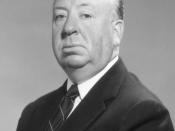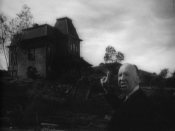In 1960 Alfred Hitchcock created a film so daring and different it is still remembered even today. Other famous films of the time being "My Fair Lady" and "The Sound Of Music", although popular these films were idealistic and picturesque. Psycho brought in the first clips of violence and nudity into cinematography. To compare Alfred Hitchcock's version of psycho to Gus Van Sant's version in 1998 is beyond doubt a problematic deed when the original was such a masterpiece.
Since psycho was released in 1960, thrillers similar to it, such as 'Silence of The Lambs', and 'American Psycho' have advanced dramatically in technology, however, they have still followed the trend set by Psycho.
When the opening credits begin, the audience is instantly seized by a strong sense of mystery and a chilling atmosphere. The music brings a sense of urgency to the credits. The atonal and screeching violins set a menacing repetitive tune, which replays throughout the film.
With most films of that era, and even with films today, along with the credits pictures are shown which begin to tell the story behind the film. Hitchcock however, uses a new and creative tactic, the opening credits begin with a black screen, which Hitchcock uses to symbolise evil and mystery. Furthermore, grey and white lines strike across the screen this is used to symbolise the schizophrenic personality of Norman, and also a criminal mind. The striking lines are representative of the plot, as they are like the slicing knife shown in the famous shower scene and the murder of the private detective.
The credits in both the 1960 version and the 1998 version follow an identical pattern with lines cutting across the screen and the same accompanying music. The only differences between the two versions is the obvious difference in...


